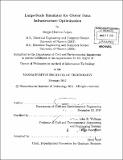| dc.contributor.advisor | John R. Williams. | en_US |
| dc.contributor.author | Herrero-López, Sergio | en_US |
| dc.contributor.other | Massachusetts Institute of Technology. Dept. of Civil and Environmental Engineering. | en_US |
| dc.date.accessioned | 2012-05-15T21:10:08Z | |
| dc.date.available | 2012-05-15T21:10:08Z | |
| dc.date.copyright | 2011 | en_US |
| dc.date.issued | 2012 | en_US |
| dc.identifier.uri | http://hdl.handle.net/1721.1/70759 | |
| dc.description | Thesis (Ph. D.)--Massachusetts Institute of Technology, Dept. of Civil and Environmental Engineering, February 2012. | en_US |
| dc.description | Cataloged from PDF version of thesis. | en_US |
| dc.description | Includes bibliographical references (p. 165-172). | en_US |
| dc.description.abstract | Companies depend on information systems to control their operations. During the last decade, Information Technology (IT) infrastructures have grown in scale and complexity. Any large company runs many enterprise applications that serve data to thousands of users which, in turn, consume this information in different locations concurrently and collaboratively. The understanding by the enterprise of its own systems is often limited. No one person in the organization has a complete picture of the way in which applications share and move data files between data centers. In this dissertation an IT infrastructure simulator is developed to evaluate the performance, availability and reliability of large-scale computer systems. The goal is to provide data center operators with a tool to understand the consequences of infrastructure updates. These alterations can include the deployment of new network topologies, hardware configurations or software applications. The simulator was constructed using a multilayered approach and was optimized for multicore scalability. The results produced by the simulator were validated against the real system of a Fortune 500 company. This work pioneers the simulation of large-scale IT infrastructures. It not only reproduces the behavior of data centers at a macroscopic scale, but allows operators to navigate down to the detail of individual elements, such as processors or network links. The combination of queueing networks representing hardware components with message sequences modeling enterprise software enabled reaching a scale and complexity not available in previous research in this area. | en_US |
| dc.description.statementofresponsibility | by Sergio Herrero-López. | en_US |
| dc.format.extent | 172 p. | en_US |
| dc.language.iso | eng | en_US |
| dc.publisher | Massachusetts Institute of Technology | en_US |
| dc.rights | M.I.T. theses are protected by
copyright. They may be viewed from this source for any purpose, but
reproduction or distribution in any format is prohibited without written
permission. See provided URL for inquiries about permission. | en_US |
| dc.rights.uri | http://dspace.mit.edu/handle/1721.1/7582 | en_US |
| dc.subject | Civil and Environmental Engineering. | en_US |
| dc.title | Large-scale simulator for global data infrastructure optimization | en_US |
| dc.type | Thesis | en_US |
| dc.description.degree | Ph.D. | en_US |
| dc.contributor.department | Massachusetts Institute of Technology. Department of Civil and Environmental Engineering | |
| dc.identifier.oclc | 788564641 | en_US |
